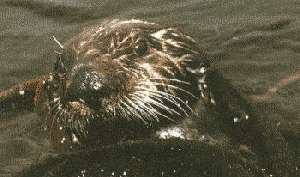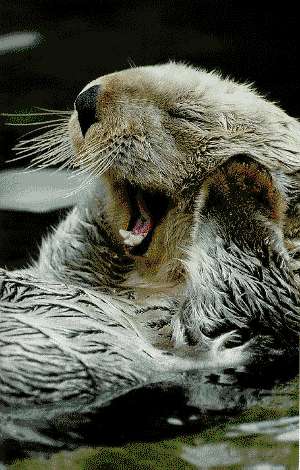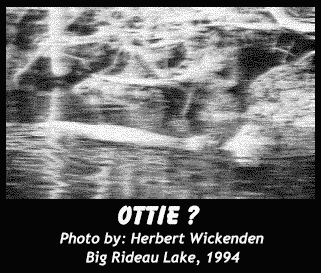

 When Europeans first came to the Rideau, they heard about a creature that lived in several of the Rideau lakes. Known as "niijikiwe nigigi inigini", which translates roughly as "Friendly Great Otter", it was held sacred by the natives of the region. At first the Europeans thought that the natives were referring to the common river otter, which frequented the lakes and rivers of the region, and which the natives refused to hunt or trap. However, as they learned more of the native legend, they found out that it was referring to a much larger creature, and that the river otters were often referred to as the children of niijikiwe nigigi inigini.
When Europeans first came to the Rideau, they heard about a creature that lived in several of the Rideau lakes. Known as "niijikiwe nigigi inigini", which translates roughly as "Friendly Great Otter", it was held sacred by the natives of the region. At first the Europeans thought that the natives were referring to the common river otter, which frequented the lakes and rivers of the region, and which the natives refused to hunt or trap. However, as they learned more of the native legend, they found out that it was referring to a much larger creature, and that the river otters were often referred to as the children of niijikiwe nigigi inigini.
 It is unclear when this legendary creature became known as Ottie. Presumably the Europeans were having trouble with the long native name. The first written reference to this creature is found in the journal of William McClegg, one of the early surveyors of the region. In November 1783, McClegg was leading a small survey party, traversing the upper part of Rideau Lake by canoe. "The waves rose up with no warning. Our craft, laden with heavy gear, foundered. The water, icy cold, closed in over our heads. Encumbered by our heavy clothes we could not but sink. As I prepared to meet my maker, I felt myself propelled up and breached the surface with some speed. Struggling to keep afloat, I saw my able assistant Jonathan appear above the waves beside me followed one after the other by our two Indian guides.
It is unclear when this legendary creature became known as Ottie. Presumably the Europeans were having trouble with the long native name. The first written reference to this creature is found in the journal of William McClegg, one of the early surveyors of the region. In November 1783, McClegg was leading a small survey party, traversing the upper part of Rideau Lake by canoe. "The waves rose up with no warning. Our craft, laden with heavy gear, foundered. The water, icy cold, closed in over our heads. Encumbered by our heavy clothes we could not but sink. As I prepared to meet my maker, I felt myself propelled up and breached the surface with some speed. Struggling to keep afloat, I saw my able assistant Jonathan appear above the waves beside me followed one after the other by our two Indian guides.
"Nee-gee-gee i-nee-gee-ni" I heard them cry out. Again, I felt myself propelled with some great speed through the water until my hand touched rock. Gasping for breath, I pulled myself out of the cold water. Looking back, I had but one glimpse of a large furry creature disappearing below the waves. As if held by the hand of our Lord, I then saw the other men, one by one, skimming along the waves, being deposited beside me, coughing and gasping for breath. I had but one more glimpse of our saviour, a flash of brown fur, nothing more.
Our guides told us that we had been saved by the Great Otter of the lake, known to the local rivermen as Ott-ee."
Sighting reports of Ottie are spotty. He seems to be a very shy animal, perhaps that is why he has been able to survive in this region for so long. Indian legend has Ottie only appearing when someone is in trouble, usually drowning. For this reason he was held sacred, with a taboo on killing any otters in the region. More recent reports appear to confirm the lifesaving nature of this creature, and that, like dolphins, Ottie has some affinity with humans, and helps those in distress.
The Facts
So, if Ottie really does exist, what exactly is he? The best scientific guess at the moment is that Ottie is a type of sea otter (Enhydra lutris) as opposed to a variation on the common river otter (Lutra canadensis). This is based primarily on the descriptions of Ottie's size, which ranges from 2 to 2.5 metres in length with a weight of around 50 kilograms. This puts Ottie at the top end of the sea otter size scale. River otters, which frequent the Rideau, are normally about 1 metre in length and weigh in at 6 to 8 kilograms, far too small to save a water laden human weighing in at 90 kilograms!
With sightings so sketchy, and no record of a specimen ever being examined, we can only speculate on the origins of Ottie. It may be that Ottie's origins date back to the Champlain sea. When the sea retreated, Ottie was left landlocked in the Rideau Lakes. His shy nature, and the fact that he was held sacred by the natives of the region protected him from the fate suffered by the mammoths and mastodons that roamed the region 8,000 years ago.
 Photographs of Ottie are extremely rare. The first photos on this page are of Alaskan sea otters. Presumably Ottie would look very much like one of these. The photo on the left is purported to be of Ottie. It has been blown up many times and enhanced as much as possible. It appears to show an otter, about 2 metres in length, lying on its back in the classic sea otter position. The size of this otter is certainly far larger than any known river otter.
Photographs of Ottie are extremely rare. The first photos on this page are of Alaskan sea otters. Presumably Ottie would look very much like one of these. The photo on the left is purported to be of Ottie. It has been blown up many times and enhanced as much as possible. It appears to show an otter, about 2 metres in length, lying on its back in the classic sea otter position. The size of this otter is certainly far larger than any known river otter.
Is it Ottie? We cannot be sure. The photographer, Herbert Wickenden of Toledo, Ohio, claims to have seen this creature frolicking on the surface for several minutes, before disappearing below the waves.
It is assumed that there is a very small population of these large otters. Otters rely on their thick fur to keep them warm in the water. This means that they have to eat quite a bit of food each day. Their diet can be quite varied, including fish, shellfish, small mammals and birds. An otter in the 50 kilogram range would need a large territory which would lead to a low population density.
River otters like to live in dens, usually those made by other animals (beavers, muskrats, etc.). Sea otters are normally found rafting with other otters in kelp beds. In a freshwater lake environment it is assumed that a sea otter would pick up on the habits of the local river otters, preferring dens, or perhaps dense marsh areas.
The low population density and a tendency to live in hidden dens or marsh areas may be the main reason for the paucity of sightings.
Sightings
Keep your eye out for Ottie as you boat through the Rideau. Send me an email if you spot him.
 Take Me Home!
Take Me Home!
Comments: send me email: kwatson@kos.net
URL: www.rideau-info.com/canal/ottie/ottie.html
© 1997-2008 Ken Watson



 When Europeans first came to the Rideau, they heard about a creature that lived in several of the Rideau lakes. Known as "niijikiwe nigigi inigini", which translates roughly as "Friendly Great Otter", it was held sacred by the natives of the region. At first the Europeans thought that the natives were referring to the common river otter, which frequented the lakes and rivers of the region, and which the natives refused to hunt or trap. However, as they learned more of the native legend, they found out that it was referring to a much larger creature, and that the river otters were often referred to as the children of niijikiwe nigigi inigini.
When Europeans first came to the Rideau, they heard about a creature that lived in several of the Rideau lakes. Known as "niijikiwe nigigi inigini", which translates roughly as "Friendly Great Otter", it was held sacred by the natives of the region. At first the Europeans thought that the natives were referring to the common river otter, which frequented the lakes and rivers of the region, and which the natives refused to hunt or trap. However, as they learned more of the native legend, they found out that it was referring to a much larger creature, and that the river otters were often referred to as the children of niijikiwe nigigi inigini. It is unclear when this legendary creature became known as Ottie. Presumably the Europeans were having trouble with the long native name. The first written reference to this creature is found in the journal of William McClegg, one of the early surveyors of the region. In November 1783, McClegg was leading a small survey party, traversing the upper part of Rideau Lake by canoe. "The waves rose up with no warning. Our craft, laden with heavy gear, foundered. The water, icy cold, closed in over our heads. Encumbered by our heavy clothes we could not but sink. As I prepared to meet my maker, I felt myself propelled up and breached the surface with some speed. Struggling to keep afloat, I saw my able assistant Jonathan appear above the waves beside me followed one after the other by our two Indian guides.
It is unclear when this legendary creature became known as Ottie. Presumably the Europeans were having trouble with the long native name. The first written reference to this creature is found in the journal of William McClegg, one of the early surveyors of the region. In November 1783, McClegg was leading a small survey party, traversing the upper part of Rideau Lake by canoe. "The waves rose up with no warning. Our craft, laden with heavy gear, foundered. The water, icy cold, closed in over our heads. Encumbered by our heavy clothes we could not but sink. As I prepared to meet my maker, I felt myself propelled up and breached the surface with some speed. Struggling to keep afloat, I saw my able assistant Jonathan appear above the waves beside me followed one after the other by our two Indian guides.  Photographs of Ottie are extremely rare. The first photos on this page are of Alaskan sea otters. Presumably Ottie would look very much like one of these. The photo on the left is purported to be of Ottie. It has been blown up many times and enhanced as much as possible. It appears to show an otter, about 2 metres in length, lying on its back in the classic sea otter position. The size of this otter is certainly far larger than any known river otter.
Photographs of Ottie are extremely rare. The first photos on this page are of Alaskan sea otters. Presumably Ottie would look very much like one of these. The photo on the left is purported to be of Ottie. It has been blown up many times and enhanced as much as possible. It appears to show an otter, about 2 metres in length, lying on its back in the classic sea otter position. The size of this otter is certainly far larger than any known river otter.